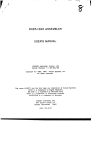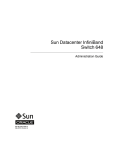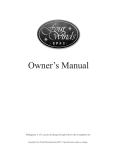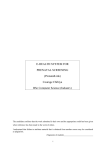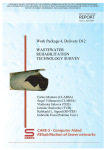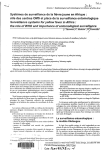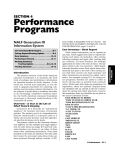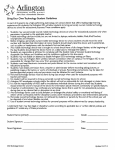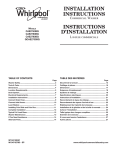Download Guidelines to Join Interbeef International Genetic Evaluations
Transcript
Guidelines to Join Interbeef International Genetic Evaluations Version 2.3 InterBeef 24 October 2012 Contact: Interbull Centre Dept. Animal Breeding and Genetics SLU Box 7023 S-75007 Uppsala SWEDEN Phone : 0046-18-671994 Fax : 0046-18-672848 E-mail : [email protected] URL : http://www.icar.org/pages/working_groups/wg_interbeef.htm ii Table of Contents 1 INTRODUCTION .......................................................................................................................... 4 2 THE ANIMAL INTERNATIONAL IDENTIFICATION .......................................................... 4 2.1 2.2 2.3 3 THE REQUIRED FILES ............................................................................................................... 6 3.1 3.2 3.3 3.4 3.5 3.6 4 FORMAT .................................................................................................................................... 4 CONSTRUCTING THE INTERNATIONAL IDENTIFICATION NUMBER ............................................... 4 THE NEW WEB INTERFACE AT INTERBULL ................................................................................ 5 THE DIFFERENT INTERBEEF STEPS ............................................................................................. 6 GENERAL PRINCIPLES FOR FILE PREPARATION: .......................................................................... 6 THE NATIONAL PEDIGREE FILE (601 FILE) .................................................................................. 7 THE PERFORMANCE FILE (602) .................................................................................................. 8 PARAMETER FILE (603) ............................................................................................................. 9 ABBREVIATIONS ...................................................................................................................... 10 FILENAMES ................................................................................................................................ 11 REFERENCES ..................................................................................................................................... 11 APPENDIX I A: CHECKPEDIGREE.PY ......................................................................................... 12 5 APPENDIX I B: CHECKLINKS.PY .......................................................................................... 14 iii 1 INTRODUCTION Countries willing to join InterBeef must be members of Interbull and support the ICAR guidelines for data collection (http://www.icar.org/). This document is a description of the necessary actions and relevant files required by a new country willing to join InterBeef. 2 The Animal International Identification 2.1 Format A unique international identification for each animal is used in the international genetic evaluation system and will be referred to as the Animal International IDentification (AIID). The AIID is constructed using the Interbull rules (referred as Interbull format in the document) and its structure is: Breed + Country + Sex + Identification number The field ‘Breed‘ of the AIID refers to the breed of identification of the animal in its country of first registration (in most cases, the country of origin): 3 characters as defined in the Interbull Breed Codes, available at www.interbull.org (see Reference section). The field ‘Country’ of the AIID refers to the country of first registration of the animal (in most cases, the country of origin): 3 characters or 3 digits number as defined in ISO 3166 Codes, available at http://userpage.chemie.fu-berlin.de/diverse/doc/ISO_3166.html (see Reference section). The field ‘Sex’ of the AIID refers to the sex of the animal (M = male ; F = female) The field ‘Identification number’ of the AIID refers to the identification number of the animal in the country of first registration: 12 characters right justified with left blanks filled in with zero (“0”). Ex: CHAFRAM006327826864 refers to A Charolais First registered in France A male With the following identification in France CHA FRA M 006327826864 Ex: BAQIRL125693456875 refers to A Blonde d’Aquitaine First registered in Ireland A female With the following identification in Ireland BAQ IRL F 125693456875 2.2 Constructing the international identification number A country should first construct the international identifications for the animals born on its soil. The general rule for this construction would be that a given identification number is unique within a country and a breed When an animal (live animal or issued from AI straw or embryo) is sold abroad, the importing country should avoid re-registration; in case of re-registration the original ID and the national ID should be kept. The animal ‘IE231112150014’ is, for example, a pure breed Irish limousine female named ‘SHRIFFTOWN RIPPER’. Ireland has constructed its AIID as followed: LIMIRLF231112150014. 4 The animal ‘FR0384106449’ is a pure breed French Charolais bull named ‘VLADIMIR’. That animal is also used in Ireland under the name ‘VLADIMER’ and the number ‘0384106449’ and has also been recodified ‘108376849’ and ‘VLR’. France constructs its AIID as followed: CHAFRAM000384106449. In the international identification number, hyphens, slashes, commas, dots, blank spaces or any other symbols are allowed. The animal ‘UK9373 70-2/-7’, for example, is a UK Salers female animal and its international identification number would be ‘SALGBRF9373 70-2/-7’ 2.3 The New Web Interface at Interbull Interbull has developed a new database, IDEA (Interbull Data Exchange Area) that allows register users to all the pedigree handling functionalities. IDEA is available at https://idea.interbull.org/ IDEA is exclusive for database users. To become a database user you need to belong to a national evaluation centre participating to the Interbeef evaluation. If you want to join the Interbeef evaluation and therefore have access to IDEA, your national genetic centre needs to be associated to a username and a contact email address. To get your national genetic centre listed among the ones participating to the Interbeef evaluation, you have to: Send an email to [email protected] providing information on your national genetic centre: Full name and address of the organization and full name and email address of the designated contact person. Clearly state the breed(s) and trait(s) you wish to participate with. If your organization provides data as a joint evaluation including other countries, you clearly have to state for which other countries and breed(s) your organization provides pedigree and performance information. Upon reception of your request, Interbull will send you by email a link to an IDEA-test environment together with a username and password so that you will be able to get acquainted with the IDEA functionalities and the user manual which is located under “Help”. The national pedigree file must be first checked with the CheckPedigree.py script provided by Interbull. The checking programs are available under “Software”. The zip files produced by the Python scripts represent the only valid infiles for the database; no other files will be accepted by the system. When your pedigree enters the database it undergoes a series of checks called “verification process” aiming at identifying the correct authoritative organization of each and every animals listed in your pedigree. In general the system has been built in such a way that it accepts information only if these comes from the authoritative organization. Therefore, whenever you submit pedigree data, the system first checks that the combination “country-breed” in the animal ID matches with the combination your organization “owns”. If so the records are considered correct and stored in the database, if this is not the case then the records will be listed in the appropriate authoritative organization account waiting for verification, i.e. waiting for the authoritative organization to provide the correct pedigree information. In case the authoritative organization is a country or organization that does not yet participate to the Interbeef evaluation, then the animals will appear as verified by Interbull until eventually that country/organization would join the service. Example: Ireland submits the following pedigree records to the database: 601 CHAIRLM458962315289 CHAIRLM789456123652 CHAIRLF369852147852 1985 OMAR IRL 601 CHAFRAM865412398745 CHAFRAM231658479851 CHAFRAF845693274125 1988 OSCAR IRL 5 In the first case the animal is an Irish Charolais sent by Ireland. Ireland is therefore the authoritative organization for that animal so the record gets stored in the database. In the second case the animal appears to be a French Charolais sent by Ireland. Ireland is no longer the authoritative organization for this bull therefore the system will send the record to the French account and will wait for France to provide its correct pedigree information. 3 The required files There are 4 groups of files to be created by a country willing to join the international beef genetic evaluation: The 601 file representing the national pedigree file The 602 file representing the national performance file (limited until now to adjusted weaning weights, adjusted carcass weight and calving ease) The 603 file representing the parameter file. The Beef Form, see Reference section. A country willing to join InterBeef needs to include at least one breed and one trait in the process of the international genetic evaluation. The objective of the present document is to help a new member country in the construction of these files. NB: Since the verification of the International ID is done via database, national cross-reference files are no longer needed. For more information about IID verification, please refer to the IDEA user manual. 3.1 The different InterBeef steps The construction of these files follows several steps: The first step for a country that wishes to join the international evaluation system is to upload the pedigree file into the IDEA database (https://idea.interbull.org/). Once the pedigree file (601) is uploaded into the database, the country will have to correct its own database according to the feedback obtained from the database regarding verified pedigree information from authoritative organizations. (see corrected foreign information in the IDEA user manual) Once this step has been fulfilled then countries will proceed sending performance file (file 602) and parameter file (file 603) to the Interbull ftp server. 3.2 General principles for file preparation: Numeric information must be right justified. Characters must be left justified. All characters should be in upper case. 6 3.3 The national pedigree file (601 file) The 601 file is a national pedigree file and must contain pedigree information of all animals included in the performance file in an animal-sire-dam format. Sires, dams and ancestors must also have an entry in this file as an animal; unknown ancestors should be coded ‘UUUUUUUUUUUUUUUUUUU’. To ensure sufficient pedigree information it is recommended that pedigree information of animals born within a period equivalent to a minimum of three generation intervals should be included. The 601 file is a file issued per country or organization providing pedigree information according to the format shown in Table 1. The 601 files can contain one breed or multiple breeds. Table 1: 601 file format (total length = 107) Field description Label Format Start Length Record type RTYPE Char Breed of the animal ABREED Char Country of birth AIDC Sex ASEX ID code of the animal AID Breed of the sire SBREED Char 25 Country of birth SIIDC Char Sex SSEX Char ID code of the sire SIID Char Breed of the dam DBREED Char 45 Country of birth DIIDC Char Sex DSEX Char ID code of the dam DIID Char Date of birth of animal BDATE Int Name of animal NAME Country sending information RCOU a Status: M Mandatory, O Optional 1 Statusa Note 3 M Example 601 International ID of ANIMAL 5 3 M I LIM Char 8 3 M II FRA Char 11 1 M III F Char 12 12 M IV 8795005065 3 O I LIM 28 3 O II FRA 31 1 O III M 32 12 O IV 95015085 3 O I LIM 48 3 O II FRA 51 1 O III F 52 12 O IV 1111001111 65 8 O V Char 74 30 O Char 105 3 M International ID of Animal’s SIRE International ID of Animal’s DAM Additional information Faust II Note I II III IV V See Reference section for Breed codes See Reference Section for Country codes – ISO 3166 Alpha-3 Sex : M Male, F Female only Identification Number in Interbull Format : Right justified, Leading blanks filled with Zero (“0”) YYYYMMDD format 7 20010130 FRA 3.4 The performance file (602) All animals with a performance must have a line as animal in the 601 pedigree file. The performance file must be constructed in agreement with the 601 file and be consistent with the international identification of the animal. It is expected that countries participating with data support the ICAR guidelines for beef recording. As indicated in the ICAR recommendations, any group of animals kept for the same purpose and at the same location shall be regarded as a whole herd. For a performance record to be considered an official record, the whole herd as defined above must be recorded. Each herd is identified with 15 digits identification, coded as characters: The first three digits correspond to the country, using the ISO 3166 Alpha-3 system, see Reference section. The next 12 digits correspond to the identification of the herd within the country. The original herd identification number should be used. The characters (letters or numbers) are right justified, the left blanks being filled with zeros. All performance traits are associated with their environmental effects and complementary information (one observation line per measurement) as described in Table 2. Table 2: 602 file format (all fields are mandatory) Field description Record type Trait Breed of evaluation Country sending information Breed of the animal Country of birth Sex ID code of the animal Label RTYPE FCODE EBREED RCOU Format Starting byte Char 1 Char 5 Char 9 Char 13 International ID of ANIMAL ABREED Char 17 AIDC Char 20 ASEX Char 23 AID Char 24 Field Lengtha 3 3 3 3 3 3 1 12 Note Example 602 I II III AWW LIM FRA II III IV V LIM FRA F 008795005065 Twinning TWI Int 37 1 VI 1 Embryo transfer ET Int 39 1 VII 0 Herd HERID Char 41 15 VIII FRA000123456789 Dependent variable Y Char 57 10 IX 245 Contemporary group CG Char 68 20 X 333 Number of environmental effects NENV Int 89 3 XI 4 included in the national model Environmental effect (n)b ENV(n) Char 93 10 XII 2 a Variable total file length, depending on the number of environmental effects included in the model (Ex. ENV(1):length = 102; ENV(2):length = 113; ENV(3):length = 124; etc.) b Repeat this field n times (n = 1,…,NENV), adding one (1) empty space between fields Notes I II III IV V VI VII VIII See trait codes in Table 4 (abbreviations) See Reference section for Breed codes See Reference section for Country codes – ISO 3166 Alpha-3 Sex : M Male, F Female only Identification Number in Interbull Format : Alpha-numeric codes only, Right justified, Left blanks being filled with Zero (“0”) birth ; 2 = twin birth 1 = single 0 = no ET ; 1 = ET Herd identification number corresponding to the herd included in the contemporary group. Format: 3 character country code + 12 digits IX X XI XII Value observed for the trait in question. Ex. 245 Kg (no decimals) Identification of the contemporary group Defines the remaining number of fields in the record. Additional fields = NENV Value of the respective environmental effect for the current record. Ex. season = 2 (out of 4 classes); birth weight = 36 (kg); sex of calf = F 8 3.5 Parameter file (603) The parameter file (603) contains the name of two variables and the names of the environmental effects for each trait included in the performance file (602). This file must be provided together with the 602 file. Table 3: Parameter file – one record per trait-breed combination (all fields are mandatory) Field description Label Format Starting byte Field Lengtha Note Example Record type RTYPE Char 1 3 603 Trait FCODE Char 5 3 I AWW Breed of evaluation EBREED Char 9 3 II LIM Country sending information RCOU Char 13 3 III FRA Reference age or class REF Int 17 5 IV 200 Trait heritability H2 Int 23 3 V 25 Contemporary group CG Char 27 20 VI HYS How CG is fitted in the model (type of effect) CGT Char 48 1 VII R Maternal (genetic) effect fitted in the model DAM Char 50 1 VIII N Maternal permanent environmental effect fitted MPE Char 52 1 VIII N in the model Permanent environmental effect fitted in the PEV Char 54 1 VIII Y model of environmental effects included in the Number NENV Int 56 3 IX 4 national model Environmental effect (n)b ENV(n) Char 60 20 X SEAS How ENV(n) is fitted in the model (type of ENVT(n) Char 81 1 VII F b a effect) Variable total file length, depending on the number of environmental effects included in the model (Ex. ENV(1):length = 81; ENV(2):length = 105; ENV(3):length = 128; etc.) b Repeat these fields n times (n = 1,…,NENV), adding one (1) empty space between fields Notes I II III IV V VI Use the trait codes in Table 4 (abbreviations) See Reference section for Breed codes See Reference section for Country codes – ISO 3166 Alpha-3 Reference value (age or class) used to adjust the dependent variable. Ex. reference national weaning age = 200 days Trait heritability used in the national evaluation, expressed in a scale from 1-100 Description of the contemporary group used. The most common are herd-year-season (HYS) and herd-year (HY). In case a different definition is adopted, describe it briefly (20 characters). VII Describes if the effect should be fitted as a fixed effect, a random effect or as a covariable in the model. Use the type of effect codes in Table 4 (abbreviations) Declare if this specific effect (DAM, MPE or PEV) is fitted into the national model (Y = yes; N = no) Defines the remaining number of fields in the record. Additional fields = 2*(NENV) Describes the nth environmental effect: Use the environmental effect codes in Table 4 (abbreviations) In case the trait is not yet included on Table 4, describe it briefly (20 characters) In case of polynomial effects, use the effect code followed by the order. Ex. (SEAS)2 should be coded SEAS2 In case of interactions, combine the effect codes in the same field. Ex. (AAWG)*(ASEX) should be coded as AAWGASEX VIII IX X 9 3.6 Abbreviations Table 4: List of abbreviations used in Interbull files and documentation Type 1 General concepts 2 Genetic evaluation methods 3 Estimates, values 4 Population parameters 5 Traits of interest 6 Type of effect 7 Model definition 8 Environmental effects Abbreviation AI ET Kg MGS NS lb AM BLUP FR MT RR RP REML ST SM BW c EBV ETA EPD ME PD PTA RBV REL SD SE TMI VAR rg rp h2 t acw aww cae stb bwt pli X F R CG Y HYS HY DAM MPE PEV AACA AAWG AAEV ASEX CSEX BIRW CLAS HERD PARI SEAS SLAH TWIN YEAR Meaning Artificial Insemination Embryo Transfer Kilogram Maternal Grand Sire Natural Service Pounds Animal Model Best Linear Unbiased Prediction Fixed Regression Multiple Traits Random regression Repeatability (model) Restricted Maximum Likelihood Single Trait Sire Model Breeding Worth Environmental correlation between records within sub-classes Estimated Breeding Value Estimated Transmitting Ability Expected Progeny Difference Mature Equivalent, records are adjusted to mature cow yield basis Predicted Difference Predicted Transmitting Ability Relative Breeding Value Reliability/Repeatability of a sire proof, given either in the scale between 0 and 1 or as percentage Standard Deviation Standard Error Total Merit Index Variance Genetic correlation Phenotypic correlation Heritability of a trait Repeatability of trait Adjusted carcass weight Adjusted weaning weight Calving Ease Sitillbirth Birth Weight Productive Life Covariable (expressed as a numerical variable in a continuous scale) Fixed effect (class variable) Random effect Contemporary group, comparison group Dependent variable Herd-Year-Season Herd-Year Maternal effects Maternal Permanent Environmental Effect Permanent Environmental Effect Age at calving Age at weighting Age at evaluation Sex of the animal Sex of calf Birth weight Classifier Herd (renumbered) Parity Season Slaughter house Twinning Calendar year 10 4 Filenames All transferred files should be written in ASCII format and use character encoding: UTF-8 Specifically for the pedigree files, organizations will find access in IDEA to two Python scripts, CheckPedigree.py and CheckLinks.py. Aim of these scripts is to assure that pedigree and linking information are correct prior entering the database environment. To run the script type at the prompt: (1) Python2.6 CheckPedigree.py –m {organization code } –f {pedigree file name} For more information about the CheckPedigree.py and the CheckLinks.py see Appendix I (a and b). If the scripts detect no errors in the pedigree or link file then a zip file “IB-ORGCODEyyyymmddThhmmss.zip.” or “IB202-org_code-yyyymmddThhmmss.zip” would be created. The zip file produced by the Python scripts represent the infile for the Interbull database; no other file would be accepted. For the time being before the database would be ready to accept performance and parameter file the nomenclature for these types of files would be: COUNTRY.BREED.FILE.TRAIT_TYPE.DATE (2) For example, a file from Ireland with performance for Limousine sent on 2010-01-18 would be called: IRL.LIM.F602.AWW_20100118 A parameter file from the same country and breed would be called IRL.LIM.F603.AWW_20100118 (1) (2) For the Org.Code, see Reference section. date yyyymmdd format References ISO 3166 Country Codes: http://userpage.chemie.fu-berlin.de/diverse/doc/ISO_3166.html Breed Codes for International Genetic Evaluation of dairy and beef http://www.interbull.org/index.php?option=com_content&view=article&id=56&Itemid=77 Guideline to Form Beef and Form_Beef: http://www-interbull.slu.se/Interbeef/General_info/framesida-general.htm InterBeef link on Interbull website: http://www-interbull.slu.se/Beef_Gen_Ev/framesida-beef.htm 11 cattle: APPENDIX I a: CheckPedigree.py Information about the program: CheckPedigree.py will perform a series of checks on your pedigree data to insure that the data is all right. If no errors are detected then a zip file will be created. The zip file represents your checked pedigree file to upload to the Interbull Centre IDEA database. The checks relate to: Check the international identification numbers (animal, sire and dam) o Correct three digit country code as in the ISO 3166 standard (no missing countries allowed) o Correct three digit breed code according to the Interbull breed codes o Correct construction of the numerical part of the ID (registration numbers, right justified, leading blanks as zeros) o Missing sires and dams shall be coded as UUUUUUUUUUUUUUUUUUU (i.e. with 19 U) Check the animal's birth date o Has to be reported in the format YYYYMMDD o If you know only the year of birth then enter it as YYYY0000 o If you know year and month of birth then enter them as YYYYMM00 o Missing birth dates are coded as 00000000 (or blanks or a single 0) Check that a male (or female) animal will eventually appear only as sire (or dam) Check for inconsistent duplicate records (different sire, dam or birthdate) Check that an animal is always younger than its parents and grandparents Before Running the Program: 1. Install Python (version 2.5 to 2.7) if necessary 2. Create a working directory/folder 3. Download the CheckPedigree.py program from https://idea.interbull.org/software and copy it to your new directory 4. Copy your pedigree file to the working directory Running the Program: Ensure there is a working network connection Use the command: python CheckPedigree.py -m <ORGCODE> -f <filename> Use your uppercase ORGCODE as shown on the upper right hand side of the IDEA page. Your organization code is reported within brackets beside the "Logged in as" information. The program checks its internal version with the value stored on the Interbull server. You will have to download the most recent version if there is a mismatch. After Running the Program: If no errors are detected, the pedigree file will be written into a zip file called IBORGCODE-yyyymmddThhmmss.zip. Upload the zip file to Interbull's data exchange site: https://idea.interbull.org/. 12 In case of errors, no zip file will be created. Please correct your data and re-run the program until the data successfully pass all required checks. Specific information about your pedigree data, descriptive statistics and a summary of errors are written to the file CheckPedigreeLog.txt. All errors are listed in detail in the file called CheckPedigreeErrors.txt. The following table describes the brief error messages more fully: Error message Description Inconsistent duplicates An animal appears twice with different sire, dam or birth date Warning duplicates An animal appears twice but with same sire, dam and birth date Illegal character errors The numerical part of the international ID is not valid The breed-country combination is not recognized Breed-country error - see file CheckPedigreeAuth.txt (created by the program) Sex coding error The sex code is neither M nor F Parent sex error A male animal (or a female) appears in the dam (or sire) column Birth date errors Malformed entry for birth date Animal appears older than its parents or grandparents Ancestor check - if a parent's birth date is unknown, grandparents are checked Note Please do not modify the program to circumvent any checks. Doing so would be pointless because the same checking routine is used again inside IDEA to double-check the pedigree file uploaded in the zip file. If you need assistance, please do not hesitate to contact us at [email protected] . 13 5 APPENDIX I b: CheckLinks.py Information about the program: CheckLinks.py will perform a series of checks in your format 202 link file to ensure that the data is all right. If no errors are detected then a zip file will be created. The zip file represents your checked links file ready to upload to the Interbull Centre IDEA database. The checks relate to: Record type: must be 202 Record length: must be 44 International identification numbers (first ID, second ID) o Correct three digit country code as in the ISO 3166 standard o Correct three digit breed code according to the Interbull breed codes o Allowed breed-country combination - see file CheckLinksAuth.txt (created by the program) o Correct construction of the numerical part of the ID (registration numbers, right justified, leading blanks as zeros) o UUUUUUUUUUUUUUUUUUU (19 U's) is only allowed for the second ID Sex code of the two IDs (they must be the same and M or F) Before Running the Program: 1. Install Python (version 2.5 to 2.7) if necessary 2. Create a working directory/folder 3. Download the CheckLinks.py program from https://idea.interbull.org/software and copy it to your new directory 4. Copy your pedigree link file to the working directory Running the Program: Ensure there is a working network connection Use the command: python CheckLinks.py -m <ORGCODE> -f <filename> Use your uppercase ORGCODE as shown on the upper right hand side of the IDEA page.Your organization code is reported within brackets beside the "Logged in as" information. The program checks its internal version with the value stored on the Interbull server. You will have to download the most recent version if there is a mismatch. After Running the Program: If no errors are detected, the pedigree file will be written into a zip file called IB202org_code-yyyymmddThhmmss.zip. Upload the zip file to Interbull's data exchange site https://idea.interbull.org/ In case of errors, no zip file will be created. Please correct your data and re-run the program until the data successfully pass all required checks. 14 A summary of errors is written to the file CheckLinksLog.txt. All errors are listed in detail in the file called CheckLinksErrors.txt. Note: Please do not modify the program to circumvent any checks. Doing so would be pointless because the same checking routine is used again at the Interbull Centre to double-check the link file uploaded in the zip file. If you need assistance, please do not hesitate to contact us at [email protected] . 15

















